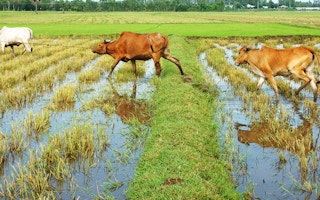A hub to its spokes. A planet to its moons. A queen bee to its hive. Most complex moving systems have a foundational core that keeps them advancing and keeps them vital.
Sustainable development is no different. The United Nations has now entered new deliberations on the Sustainable Development Goals (SDGs) that will follow on from the Millennium Development Goals when they expire next year.
Like all roads led to Rome, many of the 17 goals being discussed as part of this “post-2015 agenda” seem to lead back to one place: agricultural science.
So why is agricultural science so important?
Let’s begin with the obvious. The SDGs want to achieve access to adequate, nutritious food and enable a healthy life at all ages for all. In order to boost food production, we are going to need to equip farmers, particularly those in the developing world, with the resources to cope with increasingly erratic weather caused by climate change, and to grow more with less as natural resources grow ever more scarce. This can be achieved through science.
Back in the 1960s at the time of the Green Revolution, this meant breeding high-yielding wheat varieties that averted disastrous famine across Asia.
Today, it means releasing orange-flesh sweet potato in Mozambique and Uganda enriched with nutrients to reduce vitamin A deficiencies that cause blindness in children. It means disseminating rust-resistant wheat seeds to farmers in Ethiopia whose crops would otherwise be decimated by the deadly disease.
But agricultural science can do much more than lead the fight to end hunger.
Natural resource guardians
“
In order to boost food production, we are going to need to equip farmers, particularly those in the developing world, with the resources to cope with increasingly erratic weather caused by climate change, and to grow more with less as natural resources grow ever more scarce. This can be achieved through science.
Farmers are the guardians of the world’s natural resources. The right scientific innovations can empower them to improve, for example, water-use efficiency. Given that agriculture accounts for almost 70 percent of global water use, equipping farmers with tools to reduce the amount they use should be a priority.
Drip irrigation, for example, can reduce water used by up to 60%. In Nicaragua, we helped local farmers build earthern dams to form reservoirs that can now irrigate over 1 million hectares of rice fields. The Sustainable Development Goals are likely to call for rainwater harvesting to double.
Halting the loss of biodiversity will also fall to farmers, who must be supported to preserve the world’s forests, as well as neglected and underutilised crop species.
Finally, and perhaps most importantly, investment in agricultural science pays - literally.
As so many of the world’s rural poor rely on agriculture for their income, growth in the agriculture sector is almost twice as effective at reducing poverty than growth in any other sector.
Doubling investment in public agricultural research in sub-Saharan Africa would boost growth in agricultural output from 0.5 to 1.1 percent and bring 282 million people out of poverty.
$9 return on $1 invested
It can also achieve sustained economic growth. China and Brazil, two of the world’s biggest investors in agricultural research and development have seen productivity grow 136 percent and 176 percent respectively between 1970 and 2009. Farming is a business, and helping more people earn more money through agriculture will also propel us towards the goal of decent jobs for all.
We need to ensure that this foundation stone is not removed from the post-2015 development agenda. Agricultural research is a vital component in our journey towards a food-secure future that will also protect our natural resource base and promote economic growth in the poorest parts of the world.
For every $1 invested in research by the CGIAR partnership, $9 is returned in increased productivity in developing countries.
As we gather in New York for the CGIAR Development Dialogues on Thursday, we urge global leaders to recognise the crucial role agricultural scientists can play in sustainable development.
We come with the commitment to focus at least 60 percent of our budget, currently $1 billion dollars, on climate-smart agriculture. We pledge to reach, with our partners, half a billion farmers with climate-smart innovations. The challenges our planet faces require an ambitious response – the time to put that into action is now.
Frank Rijsberman is CEO of the CGIAR Consortium, which works on advancing international agricultural research for development. This post originally appeared on the Thomson Reuters Foundation’s Alertnet.









